The Floating Villages of Southeast Asia: Life on the Water

Updated On: April 04, 2024 by Raghda Elsabbagh
The Southeast Asian region is home to an extraordinary way of living that captures the essence of adaptability and cultural uniqueness—the floating villages. Scattered across the freshwater lakes and rivers, these floating villages of Southeast Asia have made a life on the water, creating a symbiotic relationship with their fluid environment. Each village boasts its own history, culture, and economy, primarily influenced by the geography that dictates the daily lives of its inhabitants.
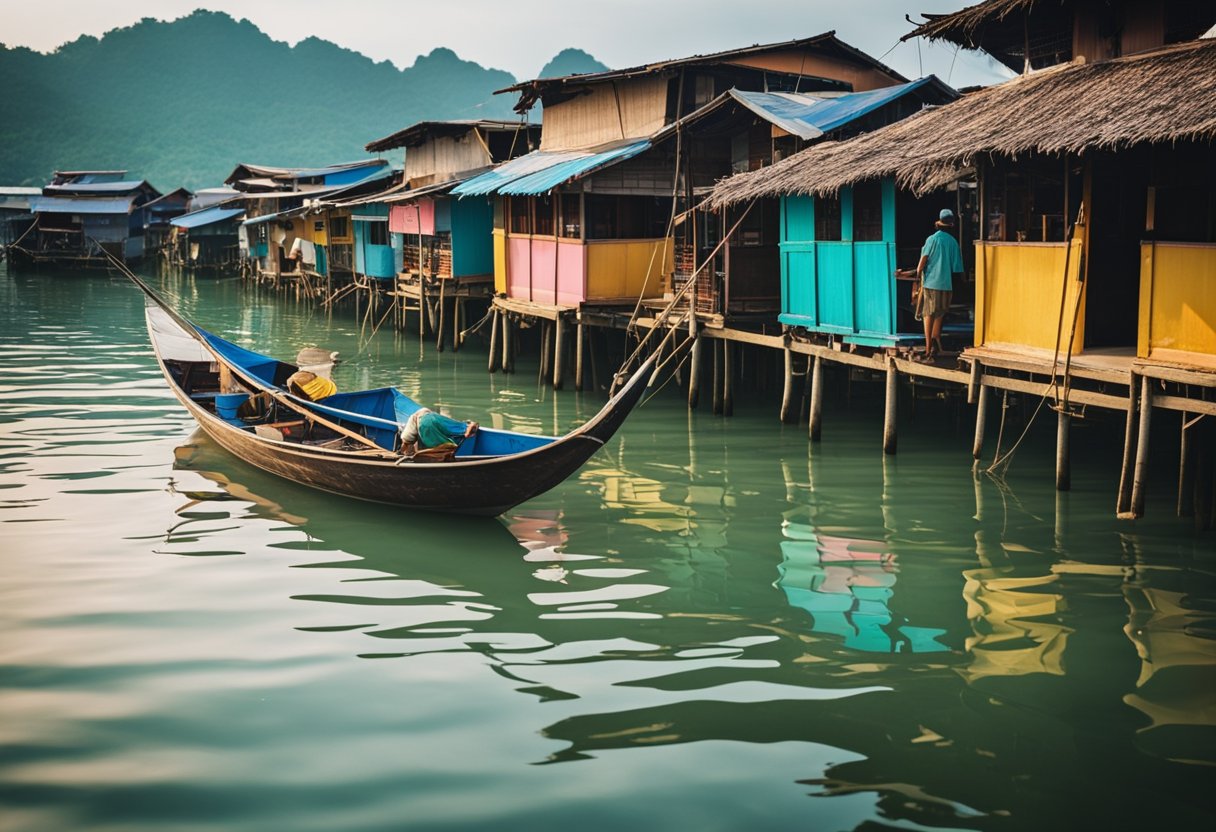
From the vast Tonle Sap Lake in Cambodia to the stilted houses of Brunei’s Kampong Ayer, these floating villages are a testament to human ingenuity in the face of geographical challenges. The architecture is adapted for fluctuating water levels, with homes, schools, and markets afloat or perched on tall stilts. Fishing is often at the heart of these communities, with local economies intertwined with the aquatic ecosystems. Despite the picturesque scenery and sense of community, life on the water comes with its own set of challenges, from sustainability to bridging the gap in education and healthcare access.
Table of Contents
Historical Context of the Floating Villages of Southeast Asia
Our focus is to shed light on how historical events have shaped life in the floating villages of Southeast Asia, particularly in Cambodia. This includes the eras of colonial rule and the profound impacts of the Khmer Rouge regime.
Colonial Influence
Under the French Protectorate in Cambodia, which lasted from 1863 to 1953, the French administration implemented significant changes in the governance and structure of the region. While they introduced modern educational systems and infrastructure, the traditional ways of life, including those in the floating villages, continued with little interference. During this period, the Tonlé Sap Lake and the Mekong River remained vital for transportation and sustenance, much as they have for centuries.
Khmer Rouge and Aftermath
Sadly, Cambodia’s historical narrative is marred by the atrocities of the Khmer Rouge regime (1975-1979). This period’s brutal genocide led to the loss of approximately 1.7 million lives due to crimes against humanity, which included forced relocations and mass executions. In the subsequent years, the floating villages offered sanctuary and a return to traditional life for some survivors, even as the nation struggled to rebuild and reconcile with this tragic history.
Geography of Daily Life
Floating villages across Southeast Asia exhibit remarkable adaptation to their aquatic environment, with daily life intricately woven into the geographic and seasonal nuances of the region’s waterways.
Seasonal Changes
The rhythm of life in these aquatic communities is distinctly shaped by the seasons, especially in areas like the Mekong River and Tonlé Sap Lake. The monsoons orchestrate drastic fluctuations in water levels, impacting every aspect of existence. The wet season sees rivers swell and lakes expand exponentially. In contrast, the dry season shrinks these bodies back, revealing vast tracts of fertile land.
During the rainy season, households become islands, with residents transitioning to boats for transportation. Conversely, the dry season allows villagers to engage in agriculture on the newly exposed banks. The water levels during these periods determine the community’s access to resources, including fishing, a primary livelihood source. Residents adjust their lifestyles to these seasonal rhythms, highlighting their resilience and sustainability practices.
Stilted Houses and Structures
Stilted houses—these are the architectural backbone of life on the water, constructed to cope with the changing water levels of the Tonle Sap and other rivers. These structures vary in height, with some perched several metres above ground to withstand the wet season’s rise, while others sit lower during the dry season. The materials used must resist rust and rot, often leading to the use of wood and bamboo, which are both sturdy and buoyant.
Around these homes, community structures such as schools and markets also navigate the fluid landscape on floats or stilts, ensuring continuous operation throughout the seasons. This design showcases residents’ intimate knowledge of their environment, allowing them to thrive in a setting that is in constant flux.
Population and Culture
As we explore the floating villages of Southeast Asia, it’s crucial to understand the people and their way of life. The communities here are as diverse as the waters they inhabit, each with its own unique cultural tapestry.
Ethnic Groups
The Khmer and Ethnic Vietnamese communities are two primary ethnic groups living within the floating villages. The Khmer are indigenous to Cambodia, often holding Cambodian Citizenship, and are the predominant group in the region. The Ethnic Vietnamese, while residing across several Southeast Asian countries, form a substantial part of the population in certain floating villages.
Local Customs and Practices
Local customs are deeply intertwined with the aquatic environment in these waterborne communities. From building techniques adapted for floating homes to livelihoods centred around fishing, the residents connect profoundly with their surroundings.
The concept of a “Community” is also vital in these villages, where social bonds are reinforced through shared practices such as communal fishing and the collective maintenance of the floating structures. These customs not only reflect the resilience of these communities but also their cultural richness.
Education and Religion
In the floating villages of Southeast Asia, the quest for education and the practice of religion have adapted to the unique lifestyle on water. Both schooling and worship occur within these aquatic communities’ confines, reflecting the inhabitants’ resilience and resourcefulness.
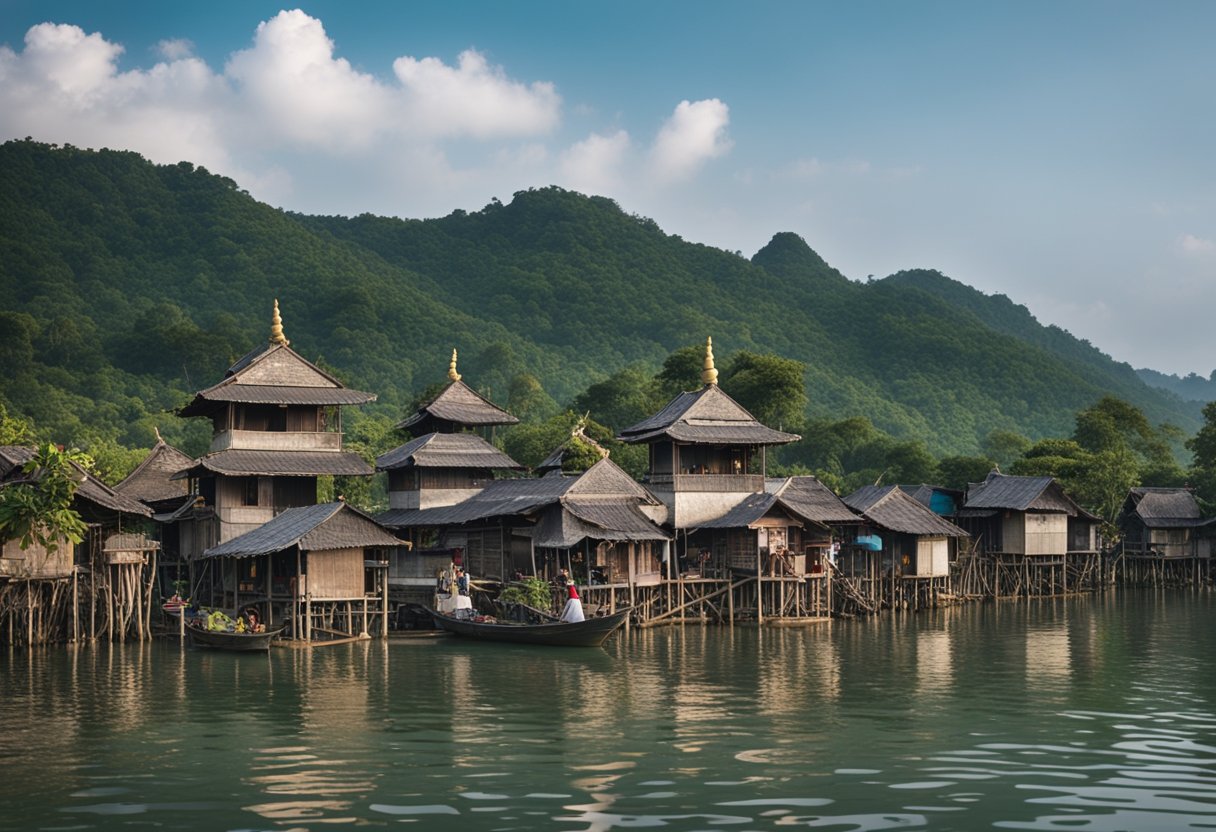
Schools on the Water
We often find that the children from the floating villages attend schools on the water, where education is delivered in structures built on stilts or floating platforms. These schools are the centrepieces of learning, providing basic education to the youngsters in these communities. With limited access to resources, educators in these floating classrooms focus on teaching literacy, numeracy, and local knowledge essential for daily life on the water.
Churches and Temples
Religion is crucial in the lives of Southeast Asia’s floating village inhabitants. Buddhism, being the predominant religion, has led to the presence of floating pagodas amidst these communities. These sacred sites serve as the religious and cultural epicentres, hosting ceremonies and daily prayers. Other religious denominations have also established their presence through churches that cater to the spiritual needs of the local Christian populace. These floating places of worship are a testament to the villagers’ dedication to maintaining their religious practices, even on the shifting waters.
Economic Activities
In the floating villages of Southeast Asia, the economy thrives on the water’s abundance, with activities such as fishing, trade, and even tourism shaping the inhabitants’ daily lives.
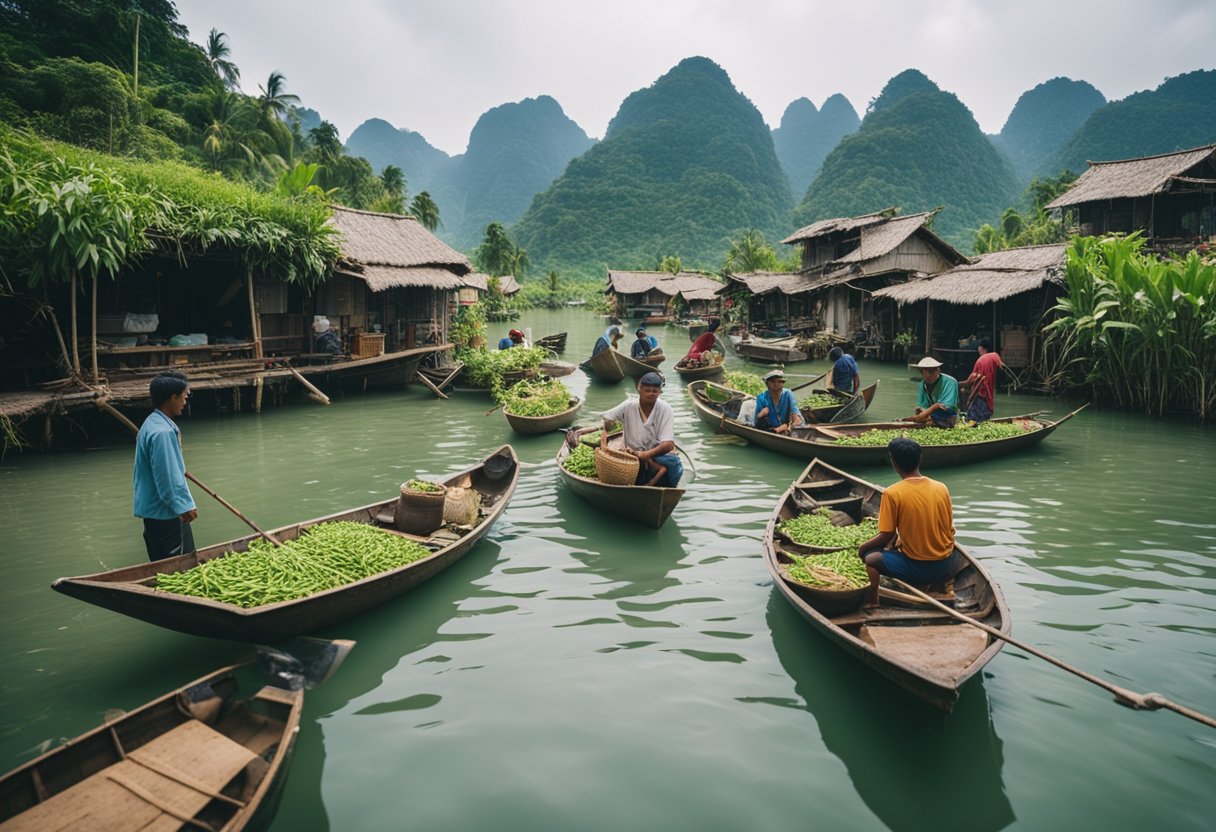
Fishing as Livelihood
Fishing stands as the cornerstone of our livelihoods within these aquatic communities. The fishermen rise with the sun to cast their nets, providing both sustenance and income for their families. Markets buzz as the day’s catch is bought and traded, demonstrating how fishing directly sustains the local economy and offers stability in a life shaped by the rhythms of water.
Trade and Markets
Beyond fresh fish, the markets found afloat or along the shorelines serve as hubs for economic exchange. Here, one can witness the bartering of goods ranging from produce to handcrafted items. Transactions are pivotal, not just for practical trade but also as social events that reinforce community bonds.
Tourism and Hospitality
The unique way of life on these waters has caught the global eye, drawing tourists eager to experience life in a floating village. We’ve embraced this interest, extending our renowned hospitality to visitors. Through guided tours and homestays, tourism has grown into a significant sector, offering an alternative source of income and fostering a greater understanding between cultures.
Challenges and Sustainability
In exploring the unique existence of the floating villages of Southeast Asia, we uncover the intricate balance between daily life and the overarching need for sustainable living. Here, we examine both the environmental pressures and the innovative solutions to ensure these communities can thrive for generations.
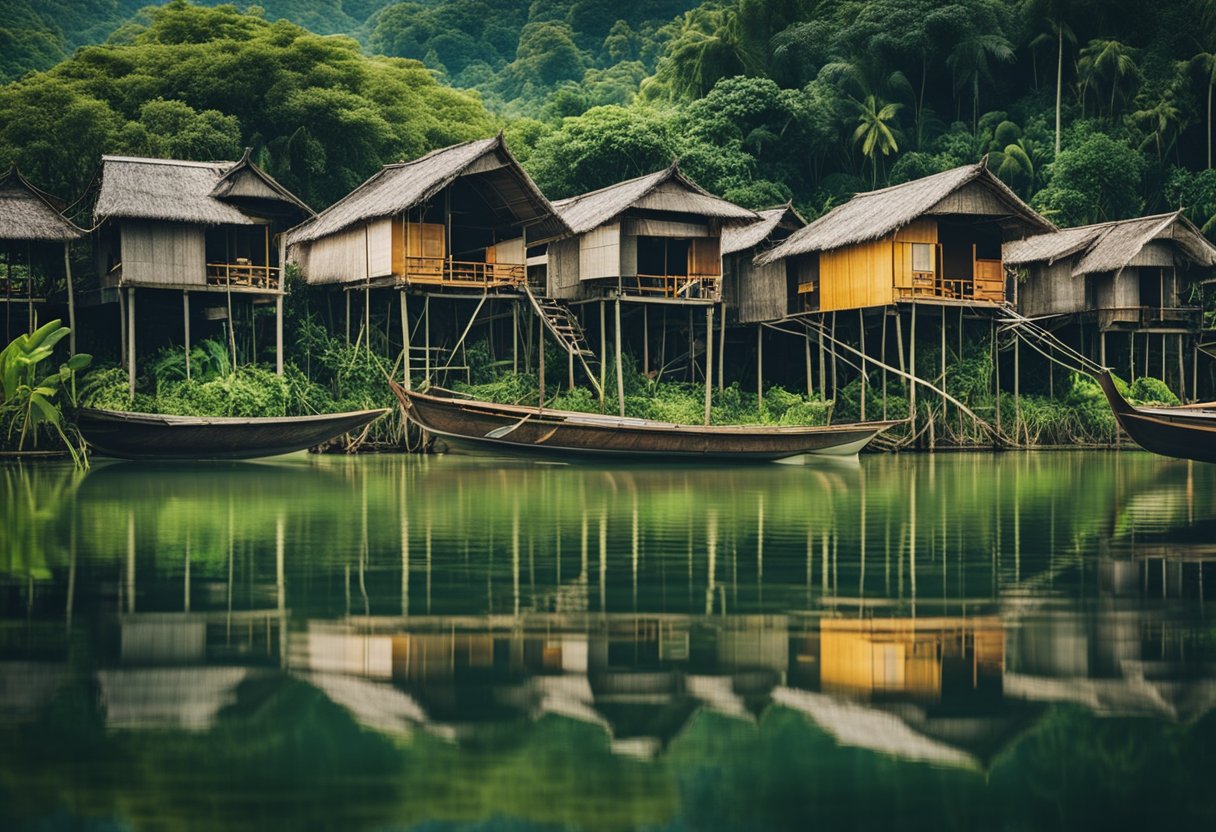
Environmental Impact
The floating villages across Southeast Asia, such as those on the Tonle Sap Lake, are keystones of local biodiversity and cultural heritage. However, they face significant environmental challenges. The ecosystem of a freshwater lake is delicate and frequently disturbed by overfishing and pollution, which endangers the aquatic life and, by extension, the villagers who rely on these waters for farming and their sustenance.
A study on the Tonle Sap Lake highlights the seasonal changes in water levels, which significantly impact the inhabitants and local fauna. During the dry season, the lake shrinks, and its depth decreases, putting pressure on the fish populations and those who depend on them. Conversely, the wet season’s expansion can lead to flooding, with homes and crops at risk.
Solutions for the Future
To address these pressing issues, a spectrum of solutions has been devised. Sustainable practices in farming and waste management are critical to decreasing the environmental footprint of these aquatic communities. Innovative programmes, like introducing beneficial bacteria to the lake to improve its sanitation, are pivotal in striving for sustainability and health protection for both the villagers and the ecosystem.
The Netherlands’ example of a floating village showcases advanced approaches to tackle the challenges of water-based living, including energy self-sufficiency and reduced environmental impact. Similar initiatives could inspire sustainable adaptations in the floating villages of Southeast Asia, ensuring that they not only survive but continue to prosper in harmony with their natural surroundings.
The Architecture of Adaptation
In the floating villages of Southeast Asia, the architecture is not merely about creating a living space but about survival and sustaining a way of life in harmony with the rhythms of water.
Engineering on Water
Constructing a home on water demands innovative engineering solutions. Bamboo plays a critical role in Cambodia due to its natural buoyancy and flexibility. This versatile material is used in building floating structures anchored in place by stilts to avoid drifting away. Floating Villages in Cambodia typically consist of clusters of bamboo houses secured with stilts driven into the riverbed or lakebed.
Architectural ingenuity is apparent in the design of these stilted houses, which are elevated above the water level to protect against flooding during the monsoon season. This practical feature ensures that daily life continues uninhibited by the rise and fall of the tides. The lightweight nature of bamboo and the resilience of the stilts allow dwellings to withstand the dynamic water environment, epitomising the adaptive nature of architecture in these regions.
Cuisine and Food Sources
In the floating villages of Southeast Asia, the local gastronomy is closely tied to the aquatic environment. The mainstay of the diet here revolves around the bounty of the lake and river systems, with intricate practices for cultivating and harvesting that have been fine-tuned over generations.
Local Delicacies
Fish and shrimp are central to the diets of those living in floating villages. A typical meal may consist of freshly caught fish, either grilled or used in soups and stews. These waters are not just a food source; they define the culinary landscape. For instance, the famed fish amok of Cambodia is a testament to the region’s reliance on aquatic resources, incorporating local spices and ingredients to create a uniquely Southeast Asian flavour.
Agriculture and Floating Gardens
While the ebb and flow of the waters dictate life here, floating villages have ingeniously developed floating gardens, which supplement the food supply. These gardens are a spectacle of resourcefulness, ensuring a steady production of fresh vegetables. Utilising the water’s surface, residents cultivate various crops such as tomatoes, cucumbers, and an array of leafy greens, enhancing both the nutritional intake and diversity of the local cuisine.
Social and Legal Issues
In the floating villages of Southeast Asia, communities face unique social and legal challenges that stem from their unusual living conditions and remote locations. We’ll examine two crucial issues: the complexities surrounding statelessness and citizenship and the human rights initiatives aimed at improving the lives of these water-dwelling populations.
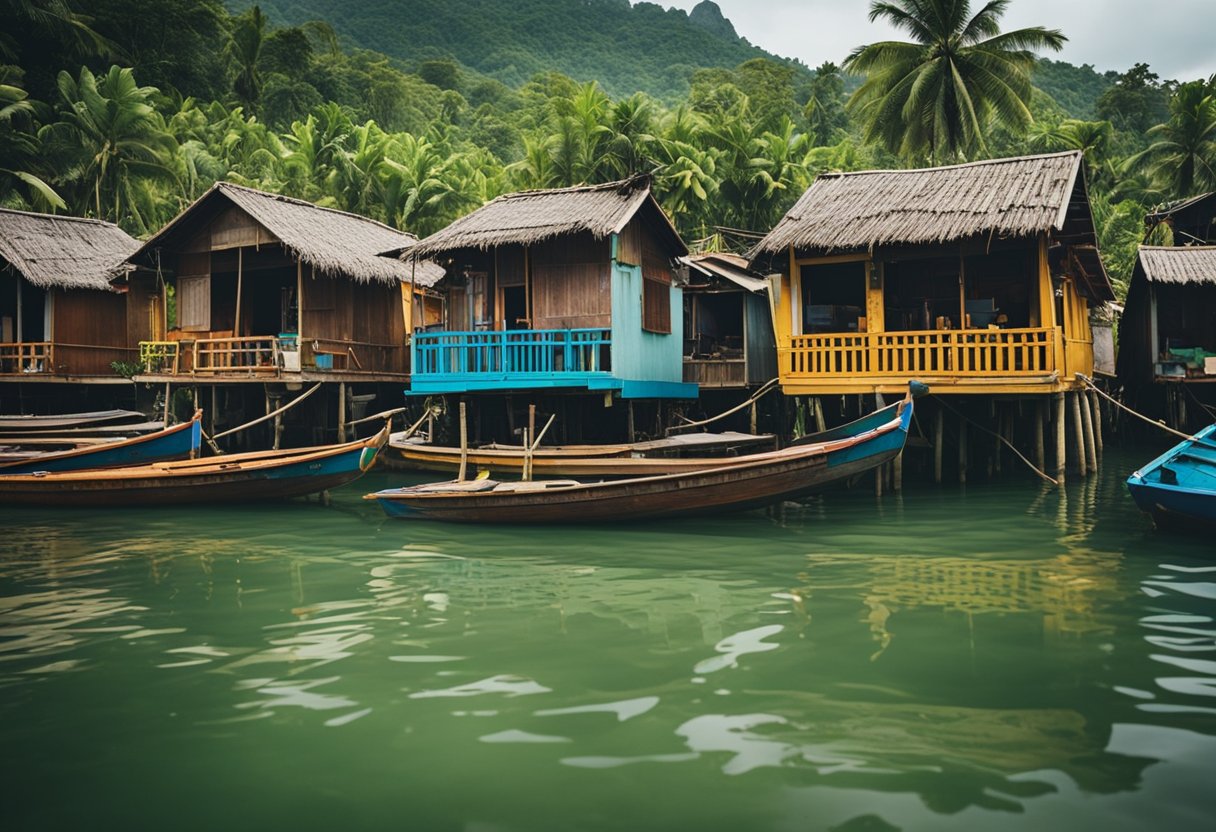
Statelessness and Citizenship
Many residents of Southeast Asia’s floating villages live without formal citizenship, rendering them stateless. This legal ambiguity often means they lack access to essential services, including education and healthcare. For instance, in Cambodia, members of floating communities, especially those of ethnic Vietnamese descent, struggle to obtain Cambodian citizenship despite being long-term or even lifelong residents. This lack of legal recognition significantly impacts their ability to secure jobs, own property, or participate in politics.
Human Rights Initiatives
Efforts to improve the situation involve various human rights initiatives, which aim to extend protection and respect for fundamental freedoms to these communities. Organisations are working to address this by advocating for the recognition of the rights of the stateless and promoting measures that enable access to citizenship. Moreover, programmes are designed to assist poor communities, enhance living conditions, provide sanitation access, and ensure sustainable livelihoods. These initiatives seek to not only address immediate needs but also to foster long-term empowerment and self-reliance.
Cultural Representations
Before we explore the intricacies of the floating villages of Southeast Asia, it’s essential to understand their profound cultural representations. These communities exhibit the local people’s resilience, ingenuity, and rich traditions.
Art and Media
In the floating villages, art and media serve as a mirror reflecting a lifestyle intrinsically linked with the ebb and flow of water. Here, hospitality is not a mere industry; it’s an art form deeply rooted in a tradition of welcoming travellers with open arms. The villagers, with their genuine smiles and eagerness to share their way of life, are often the subjects of captivating photographic essays and documentaries. Photographers travelling to these waterborne communities find themselves spellbound by the vivid tableau of daily life, from homes on stilts brimming with activity to boats doubling as market stalls.
The portrayal of these villages in various media plays a vital role in raising awareness about the uniqueness of these communities. They highlight not only the captivating visuals but also the challenges the local community faces, primarily due to environmental changes and modernisation pressures. By bringing these stories to the fore, both local and international artists contribute to a narrative that fosters a better understanding and appreciation of the cultural fabric that defines these floating enclaves.
Taking photos in these areas is not just about capturing images; it’s about preserving moments in time and a way of life that remains largely undisturbed by the rapid pace of outside development. It’s a respectful exchange, a dialogue where the photogenic landscapes and vibrant local life become a source of visual storytelling that beckons the broader global community to witness, appreciate, and safeguard these extraordinary living traditions.
Frequently Asked Questions
In this section, we shed light on common inquiries regarding Southeast Asia’s unique and culturally rich floating villages.
What are the primary reasons for the establishment of communities in floating villages?
Floating villages arose out of the necessity to adapt to aquatic environments. The availability of resources and livelihoods, particularly fishing, drove communities to establish these settlements. In some cases, geographical challenges necessitated the creation of homes on water for direct access to resources and navigational purposes.
Can you provide an overview of the historical development of Southeast Asia’s floating villages?
Floating villages have been part of Southeast Asia for centuries, evolving from simplistic dwellings to complex communities. Originating as a solution to the monsoon season’s ebb and flow, these villages have grown into permanent habitats that preserve cultural traditions and demonstrate remarkable adaptability to the aquatic lifestyle.
What key advantages does Tonle Sap Lake offer the surrounding communities?
Tonle Sap Lake, the largest freshwater lake in Southeast Asia, provides bountiful fishing grounds and agricultural opportunities. The lake’s variable size ensures a nutrient-rich environment, supporting both biodiversity and local livelihoods, which is crucial for the floating villages’ sustenance
Which floating villages near Siem Reap are accessible to visitors?
Visitors can experience the floating villages near Siem Reap, such as Mechrey, Kampong Khleang or Prek Toal. These communities offer insights into the authentic way of life on the water while emphasising responsible tourism and community benefits.






